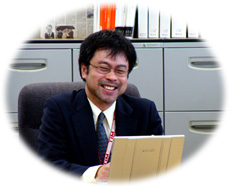- HOME
- >
- About The Cyber Communications Laboratory Group
- >
- Overview Of Organization
- >
- Cyber Solutions Laboratories
- >
- Introduction to Projects
- >
- Human Interaction Project
About The Cyber Communications Laboratory Group
Cyber Solutions Laboratories
Human Interaction
Project

Project Manager
We are undertaking R&D into the interfaces between humans and machines or the environment, with a view to developing useful, easy-to-use and well-designed services and appliances for the user. The ultimate goal is to help create new businesses, made possible through broadband and ubiquitous communication.
(1) Network robot technology
In anticipation of the coming age of personal robots, we are studying the framework (network robot platform) for executing diverse services through collaboration between various robots connected to the network. For this purpose, we have classified robots into three broad categories (the physically tangible, visible type, the hidden type built into the environment, and the virtual type typically represented by a computer graphics character), and are studying the architecture and components to connect robots to the network and enable organic collaboration between them. Based on the technology of and experience with the Factory Data Center (FDC), a factory information sharing platform for a commercial application service provided by an NTT Group company, we have proposed a 3-layer architecture reflecting different levels of requirement for real-time operation, and have developed prototype robot systems. In addition, in order to demonstrate specific, real, robot-based services and to evaluate them, we are doing applied research into a communication service that uses future robot-type terminals.
(2) Visual-field-sharing-type remote collaboration technology
We have developed SCOPE (Sight Collaboration by Projection Effect), a real-space visual-field-sharing-type collaboration system that enables skilled engineers at a remote site to support craftsmen performing maintenance or inspection at a factory or a data center. SCOPE achieves remote collaboration by having a camera and a projector installed at the work site so that the craftsman can receive support from a skilled person as if they were in the field side by side. For example, a wiring diagram or an operation can be shown on a screen above the related device, or the contents of a manual can be displayed on any convenient surface, thereby increasing work efficiency. Future application areas of SCOPE include the inspection and diagnosis of faults on telecommunications equipment, maintenance work on factory equipment, and teaching at educational institutions.
(3) Air Interface
To realize a communication medium for ‘sense of touch’ with no constraint imposed on the user, we have developed “Air Interface” technology that uses air pressure to present the feeling of touch.
An air jet is released from one of a number of nozzles embedded in a table and aimed towards a concave air receiver held by the user. The impact on the air receiver makes the user's hand feel that a virtual object is on the table. To represent the position of the virtual object, air jets from nozzles laid out on a two-dimensional plane are controlled in coordination with the display of the virtual object.
Conventional technologies for producing a sense of touch require an arm or a wire attached to the user. The problem with these approaches is that user feels tethered, and also that it is difficult to ensure safety because the arm may be moved rapidly. The air interface has two advantages. First, even if the air flow is varied rapidly to represent a fast-moving object, no excessive force is applied to the user. Second, it requires no wires or other items to be attached to the user. So the air interface technology is safe and does not constrain the user, two qualities which are essential if the interface is to be used as a tool in daily life.
